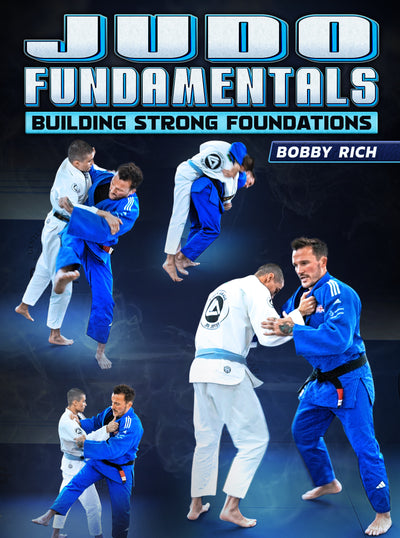No Gi Ko Ouchi Gari With Travis Stevens
One question that people often have about Judo is its ability to translate outside of its own specific context of gi oriented grappling. In this clip we have Silver medal Olympian Judoka, John Danaher blac belt and Judo Fanatics tutor Travis Stevens giving a great demonstration of a no gi set up for Ko Ochi Gari leading to positive controlling momentum on the ground.
First Travis starts with a classic no gi standing technique, the arm drag to take control of the back. For the arm drag Travis starts with a grip very instinctive to Judoka, but modified, which is a wrist grab. In Judo this would typically be a sleeve grab with the little finger being most active in the grip of the sleeve material being pulled tight around the wrist. Instead as this is no gi the grip goes directly for the wrist with a standard thumb and finger grip.
Join the JUDO ACADEMY! Click Learn More!
From the wrist grab with his lead hand Travis then comes on the inside with his rear hand and takes an inside position with his arm and a ‘C’ grip on the back of his opponents elbow. This combination of grips and arm positions create a mechanically tight and strong control over the opponents’ arm so that we can move them around without the additional appendage of the gi.
As Travis pulls through for the back take however his opponent is countering by applying the same arm drag against Travis!
In this situation the stronger person will tend to end up on the back. We don’t want this kind of simple trade for standing control so this is where Judo can be employed to mix up the standing techniques and create a successful take down using strategy and misdirection.
From a failed arm drag to the back Traivs now switches to a no gi version of Ko Ouchi Gari.
First we will look at the orthodox Ko Ouchi Gari so we can understand the no gi version, and how this technique can be chained together with a wrestling staple, the arm drag.
Ko Ouchi Gari (meaning Small Inner Reap in English) is a staple of the Judo takedowns, and is included in the original forty throws developed and employed by Judo founder Jigoro Kano. It belongs in the Dai Ikkyo (first group) of traditional throws of Kodokan Judo, and as such is amongst the first throws a Judoka will learn.
The standard Ko Ouchi Gari practised in the gi begins with the orthodox high sleeve and lapel grip found in traditional Judo. The kuzushi (breaking balance) begins with a pulling upwards and towards yourself on both the lapel and sleeve to bring our opponents weight onto the balls of their feet. After this our hands and feet work together to drive forwards into our opponent at the same time. The grip on the lapel hand pressures forwards into the inner shoulder and the whole forearm presses into their body. At the same time the sleeve grip is pressuring forwards, and the feet drive in to initiate the reap.
A key detail here is that the direction of our feet must be in line with the direction of our throw. If the back foot is not in line with the throw but instead left so that our toes are pointing away from us and our heel is pointing in towards us this will leave us open to be countered as the foot is now not active in our drive and balance.
The no gi variation Travis shows here still uses kuzushi as the foundation of the throw, but without the gi it needs to be set up differently.
Travis begins with the same set up for the arm drag, taking a two-on-one control on his opponents arm, which extends and brings their weight onto their lead leg. Instead of stepping around them to take their back Travis brings his lead leg inside his opponents lead leg, which is now their weight bearing and immobile leg. At this point Travis knee is inside his opponents knee, and his heel is behind his opponents heel.
As Travis’ opponent tries to step around to complete their own arm drag Travis controls them with an underhook on their far side and is blocking their movement with the hooking leg of Ko Ouchi Gari.
Key detail: The reaping leg is not planted into the floor but instead fluidly moves over the surface of the mats in order to reap our opponents heel away from them and in the direction of their own foot.
Once this sweep has been completed we will land in our opponents half guard and as we have an underhook Travis tucks his elbow with his thumb pointed towards the ceiling to avoid the omoplata or arm attacks. The tucked elbow gives us a good frame against our opponent and makes sure we can continue our offensive momentum now we have successfully taken our opponent to the ground.

For more game changing information on mastering the standing game and creating positive controlling momentum to the floor see The Judo Academy by Jimmy Pedro and Travis Stevens here!



